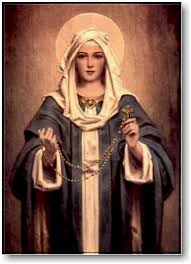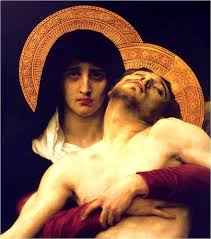Our Lady of Sorrows
 Today we celebrate the Memorial of Our Lady of Sorrows. This title of the Blessed Mother is particularly meaningful for me and holds much significance. As many of you know, Our Lady was my constant spiritual companion as I sojourned through the pilgrimage of pain I experienced when my son, Simon, was killed in a vehicular accident shortly after his return from Iraq.
Today we celebrate the Memorial of Our Lady of Sorrows. This title of the Blessed Mother is particularly meaningful for me and holds much significance. As many of you know, Our Lady was my constant spiritual companion as I sojourned through the pilgrimage of pain I experienced when my son, Simon, was killed in a vehicular accident shortly after his return from Iraq.
I contemplated the wounds of Mary’s immaculate heart, inflicted by her seven swords, and found in them a safe refuge in which I could place my own broken heart and bruised emotions. With maternal love and comfort, she procured for me from her Spouse, the Holy Spirit, the grace I needed to find hope and healing.
Then, when my husband was diagnosed with terminal brain cancer 51 weeks after Simon’s death, Our Lady of Sorrows once again mothered my soul, tending to me with maternal beatitude and grace.
Of course, when I speak of such things, I refer to those intimations of the heart that come to us in prayer and upon reception of the sacraments of the Church. In those holy moments, the veil of our understanding is sometimes lifted and we catch a glimpse of the eternal realities. Then, we see what a mother we have in Our Lady! This daughter of the Father, mother of the Son, and spouse of the Holy Spirit advocates, intercedes, and procures so much for us before the throne of God!
We should not be surprised that the Blessed Mother does such things for us. She is, after all, our spiritual mother, anticipated by the Father (Genesis 3:15) and given to us by her Son when He experienced His final agony (John 19: 26-27). This is the consistent teaching of the Church from her earliest days.
The document of the Second Vatican Council, Lumen Gentium, states the Church’s teaching beautifully:
61. Predestined from eternity by that decree of divine providence which determined the incarnation of the Word to be the Mother of God, the Blessed Virgin was in this earth the virgin Mother of the Redeemer, and above all others and in a singular way the generous associate and humble handmaid of the Lord. She conceived, brought forth and nourished Christ. she presented Him to the Father in the temple, and was united with Him by compassion as He died on the Cross. In this singular way she cooperated by her obedience, faith, hope and burning charity in the work of the Saviour in giving back supernatural life to souls. Wherefore she is our mother in the order of grace.
62. This maternity of Mary in the order of grace began with the consent which she gave in faith at the Annunciation and which she sustained without wavering beneath the cross, and lasts until The eternal fulfillment of all the elect. Taken up to heaven she did not lay aside this salvific duty, but by her constant intercession continued to bring us the gifts of eternal salvation.(15*) By her maternal charity, she cares for the brethren of her Son, who still journey on earth surrounded by dangers and difficulties, until they are led into the happiness of their true home. Therefore the Blessed Virgin is invoked by the Church under the titles of Advocate, Auxiliatrix, Adjutrix, and Mediatrix.(16*) This, however, is to be so understood that it neither takes away from nor adds anything to the dignity and efficaciousness of Christ the one Mediator.
It is from the entrustment of Our Lady to St. John and the entrustment of St. John to Our Lady that our understanding of her spiritual maternity flows as well as the Church’s devotion to her as Our Lady of Sorrows. St. John stood with Mary at the foot of the cross. He witnessed first hand her holy grief and affliction, her steadfast devotion to her Son, and her maternal entrance into His sufferings.
Devotion to Our Lady of Sorrows grew during the Middle Ages as well as art work depicting the swords in her heart. These seven swords represent the seven main sorrows of Our Lady’s life. I have found it interesting to reflect upon the fact that the Jewish understanding saw the number seven as the number of perfection. From this perspective, then, though no blood flowed from physical wounds, she suffered interiorly to the superlative degree.
While the list has varied through time, since the 14th century, these seven chief sorrows of May have been called her seven dolors and were listed as:
The Prophesy of Simeon (Luke 2: 33-35)
The Flight into Egypt (Matthew 2: 13-15)
The Loss of the Child Jesus for Three Days (Luke 2: 41-52)
Meeting Jesus on the Way to Calvary (Luke 2: 25-40; Lam: 1: 12; John 19: 26-27)
The Crucifixion and Death of Jesus (Matthew 27: 27-53)
Jesus is Taken Down from the Cross (Luke 23: 50-53)
Jesus is Laid in the Tomb (Luke 23: 53-56)
As our spiritual mother, Mary wants to help us in our travail. She wants to intercede for us and obtain the grace we need to experience healing and hope. Reflecting on this, Father Faber, a 19th century priest who plumbs the depths of Our Lady’s sorrows in his classic work, The Foot of the Cross, tells us that we should seek to see Our Lord’s passion through the loving eyes of His mother. Her tenderness and her beatitude can help us in our own struggles, suffering, and pain. She wants to share with us the operations of grace she received into her own soul as she offered all of her sufferings to God the Father for our sake and for the sake of the whole world.
“O Sorrowful and Immaculate Heart of Mary, pray for us who have recourse to thee.” Amen.
(The historical section of this post are taken from my first video teaching in a new Women of Grace® study to be released in the near future. Called Healed for Holiness: Mending the Wounds of the Heart, this study is dedicated to the Blessed Virgin Mary under her title of Our Lady of Sorrows. Watch my blog for the announcement of its release.)
 Today is the Feast of the Queenship of the Blessed Virgin Mary. This Feast was established by Pope Pius XII in 1954 and concludes the octave of the Feast of the Assumption. Pope Pius XII stated that,
Today is the Feast of the Queenship of the Blessed Virgin Mary. This Feast was established by Pope Pius XII in 1954 and concludes the octave of the Feast of the Assumption. Pope Pius XII stated that,










 Today we celebrate the Feast of Our Lady of the Rosary. This prayer, though simple in form, is really a way to take us to the depths of union with God. The following is from The Women of Grace Foundational Study Guide.
Today we celebrate the Feast of Our Lady of the Rosary. This prayer, though simple in form, is really a way to take us to the depths of union with God. The following is from The Women of Grace Foundational Study Guide.  foot of the cross. He witnessed first hand her holy grief and affliction, but witnessed as well her steadfast devotion to her Son and her maternal entrance into his sufferings.
foot of the cross. He witnessed first hand her holy grief and affliction, but witnessed as well her steadfast devotion to her Son and her maternal entrance into his sufferings. Yesterday the Church celebrated the Feast of the Birth of Mary and encouraged us to turn our hearts and our minds to her in a special way. She is, after all, the woman whose “yes” birthed Salvation to the world.
Yesterday the Church celebrated the Feast of the Birth of Mary and encouraged us to turn our hearts and our minds to her in a special way. She is, after all, the woman whose “yes” birthed Salvation to the world.
 Today we celebrate the Memorial of Our Lady of Sorrows. This title of the Blessed Mother is particularly meaningful for me and holds much significance. As many of you know, Our Lady was my constant spiritual companion as I sojourned through the pilgrimage of pain I experienced when my son, Simon, was killed in a vehicular accident shortly after his return from Iraq.
Today we celebrate the Memorial of Our Lady of Sorrows. This title of the Blessed Mother is particularly meaningful for me and holds much significance. As many of you know, Our Lady was my constant spiritual companion as I sojourned through the pilgrimage of pain I experienced when my son, Simon, was killed in a vehicular accident shortly after his return from Iraq. 